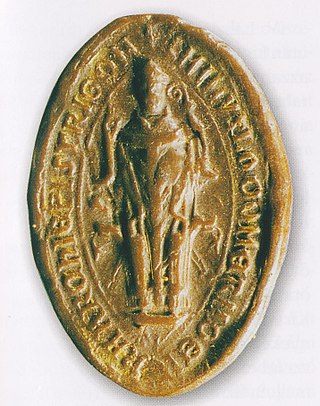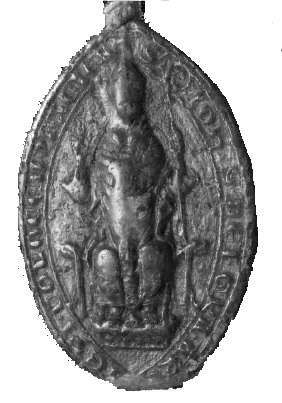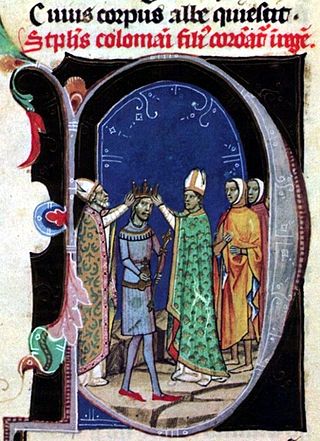Matthias from the kindred Rátót was a Hungarian prelate in the first half of the 13th century, who served as Bishop of Vác from 1238 to 1240, then Archbishop of Esztergom from 1239 until his death in the Battle of Mohi. He was the first Archbishop of Esztergom who was referred to as Primate of Hungary.
Fancica or Francica was a Hungarian prelate at the turn of the 11th and 12th centuries, who served as Bishop of Zagreb from around 1125 to 1131, then Archbishop of Kalocsa from 1131 until his death.
Desiderius or Ders was a Hungarian prelate in the 11th century, who served as Archbishop of Kalocsa from around 1064 to 1076.

Nehemiah was a Hungarian prelate and politician, who served as Archbishop of Esztergom in the 1070s, during the reigns of Géza I and Ladislaus I of Hungary.
Macarius was a prelate in the Kingdom of Hungary in the first half of the 12th century. He was successively provost of Titel around 1127, bishop of Pécs between around 1136 and around 1139, and finally archbishop of Esztergom, until around 1147.
Kalán from the kindred Bár-Kalán was a prelate and royal official in the Kingdom of Hungary at the turn of the 12th and 13th centuries. He was bishop of Pécs from 1186 until his death in 1218, and ban of Croatia and Dalmatia between 1193 and 1194, thus he was the first prelate in the kingdom to parallelly held a secular office. Kalán's relationship with the monarch was tense in the reign of King Emeric who accused the bishop of incest but could never prove it. Although a part of the canons of Esztergom elected Kalán as archbishop in 1204, his election was not confirmed by the Holy See. Kalán died when planning to go on a crusade to the Holy Land.

John was a prelate in the Kingdom of Hungary in the 12th and 13th centuries. He was Bishop of Csanád between 1198 and 1201, Archbishop of Kalocsa from 1202 to 1205 and Archbishop of Esztergom between 1205 and 1223. He crowned Ladislaus III of Hungary, Andrew II of Hungary and Coloman of Galicia as king. Andrew II appointed him to govern the kingdom during his crusade between 1217 and 1218.

Lodomer was a prelate in the Kingdom of Hungary in the second half of the 13th century. He was Archbishop of Esztergom between 1279 and 1298, and Bishop of Várad from 1268 till 1279. He was an opponent of Ladislaus IV of Hungary whom he excommunicated for failing to force the Cumans to adopt the Christian way of life. After Ladislaus' death, Lodomer and his suffragans were dedicated supporters of Andrew III of Hungary, who aimed to restore strong royal power against the rebellious lords and oligarchs.
Gregory Bicskei was a prelate in the Kingdom of Hungary at the turn of the 13th and 14th centuries. He was the elected Archbishop of Esztergom between 1298 and 1303. Supporting the claim of the Capetian House of Anjou, he was a tough opponent of Andrew III of Hungary. He crowned Charles I king with a provisional crown in 1301. He was murdered in Anagni by soldiers whom Philip IV of France had sent to Italy to capture Pope Boniface VIII.

John Hont-Pázmány was a prelate in the Kingdom of Hungary at the turn of the 13th and 14th centuries. He was Archbishop of Kalocsa between 1278 and 1301. In this capacity, he closely cooperated with fellow Archbishop Lodomer in order to restore royal authority over the kingdom. After Lodomer's death, John became head of the royal council from 1298 to 1301, initiating profound constitutional changes in the parliamentary system. He crowned Wenceslaus, one of the pretenders to Hungary, king in 1301, provoking the wrath of the Holy See.
Apa or Appa was a nobleman in the Kingdom of Hungary in the second half of the 12th century, who held courtly positions and elevated into the dignity of Ban of Slavonia during the last period of the reign of Géza II of Hungary.
Marcellus was a Hungarian prelate at the turn of the 11th and 12th centuries, who served as Bishop of Vác from around 1111 to 1113, then Archbishop of Esztergom from around 1116 until his death.

Lawrence was a Hungarian prelate at the turn of the 11th and 12th centuries, who served as Archbishop of Esztergom from around 1105 until his death. He was a faithful confidant of Coloman, King of Hungary and the initiator of large-scale church organizational and canon law reforms in the Kingdom of Hungary.
Acha was a Hungarian prelate in the second half of the 11th century, who served as Archbishop of Esztergom from around 1087 to 1090.
Felician was a Hungarian prelate in the first half of the 12th century, who served as Archbishop of Esztergom from around 1125 until his presumably death in 1139 or later.
Martyrius or Martirius was a Hungarian prelate in the 12th century, who served as Bishop of Veszprém from around 1127 to 1137, Bishop of Eger from 1142 to 1150, and finally Archbishop of Esztergom from 1151 until his death.
Nicholas from the kindred Kán was a Hungarian prelate in the second half of the 13th century, who served as Archbishop-elect of Esztergom in 1273, and from 1276 until 1278. Simultaneously, he held various posts in the royal chancellery. As a loyal partisan of queen regent Elizabeth, he was an active participant in the feudal anarchy, when groupings of barons fought against each other for supreme power during the minority of king Ladislaus IV. For which, papal legate Philip of Fermo excommunicated him.

Paul from the kindred Balog was a Hungarian prelate in the 13th century, who served as Bishop of Veszprém from 1263 until his death. Simultaneously, he also held various positions in the royal court.
Peter was a Hungarian noble in the late 11th century, who served as Palatine of Hungary around 1091, during the reign of Ladislaus I of Hungary.
The Concordat of 1169 was an agreement between the Kingdom of Hungary and the Papal States, signed by Stephen III of Hungary and Cardinal Manfred of Lavagna, the papal legate of Pope Alexander III in Veszprém or Esztergom in 1169.




